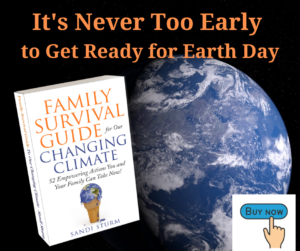Many years ago, we drove my granddaughter and her friend 40 miles to the mall (we lived in rural Alaska). Phones were already a thing, and their 10-year-old fingers were texting as fast as they could – with an occasional giggle. No more than two words were spoken the entire ride.
Years later, we found out they were texting each other. They were probably talking about our choice of music and what they would do at the mall.
Imagine starting conversations among young people about climate change and what significant innovations are being developed. Or talk about sustainable living practices when responding to negative talk about environmental issues. Children and climate change cannot be separated.
It could be a beautiful thing turning such negativity into a positive outlook on life.
Children and Climate Change: 10 Ways for our Youth to Get Conversations Started About Our Changing Climate
- Climate change is a global issue that affects us all, and children need to be educated and informed about its causes and effects. The effects of climate change are already visible in our environment, and children must understand the importance of taking action to reduce their carbon footprint and help protect our planet.As adults, living by example is one of the best ways to teach others. No need to explain yourself – live sustainably.
Talking to other children about climate change is a great way to spread awareness and inspire others to look closely at their impacts.
- Researching and discussing solutions is an excellent way for children to get involved and make a difference. They can investigate renewable energy sources, sustainable farming practices, and other solutions that can help reduce the impacts of climate change. Children can also brainstorm and work together to come up with creative solutions.There are many opportunities for discussion. For example, visiting your local organic farmer’s markets during the season is a great time to compare foods grown in your area versus those found in grocery stores with labels from other countries. As a result, they taste better, they use less energy, and you are supporting the local community.
- Becoming active with local environmental groups, volunteering for local clean-up days, and participating in events that raise awareness creates plenty of stories to share. By working together, children can help reduce their carbon footprint and make a difference in their community.
- Reaching out to family and friends is another way for children to spread the climate message. They can share facts and information about climate change and encourage others to act.However, living by example is the most effective way to teach. For example, when you go out, bring a cool reusable drink container instead of accepting bottled water. Other children will want to have one of their own. Decorating drink bottles are a great after-school craft activity. Or have a unique picnic basket with reusable plates and utensils to take on nature outings.
- Joining other children to organize events and rallies can build a strong community of like-minded youth.
- Writing letters to elected officials is a great way to urge their elected officials to support sustainable legislation.
- Using social media to share activities can motivate others to act. For example, they can create videos, post articles, and share pictures to engage their audience and inspire others to make a difference.
- Planting trees and other plants is a great way to help reduce carbon dioxide in the atmosphere. Children can join tree-planting events or start their own projects. Begin at a local nursery to learn about the best species for your region.
- Planting an organic vegetable garden and starting a compost bin brings many benefits. Children can invite other children over to pick veggies and cook a special meal together. This experience triggers all the senses and plants the “seed” to have their own garden someday.
- Starting conversations with adults who have experience in the field is a way to get questions answered.
I want to suggest you begin by having conversations with your children. Promote the sharing of positive information and not gloom and doom. Give them access to success stories and incredible innovations. Then, once they begin participating in community activities, they will have plenty to share, especially if you make them the reporter for the day.






